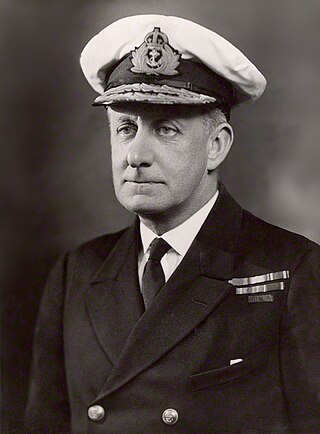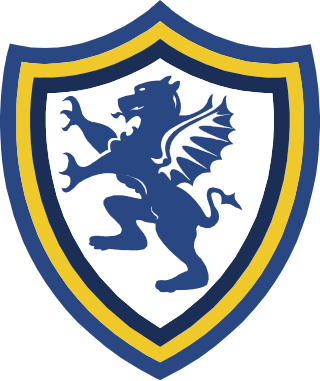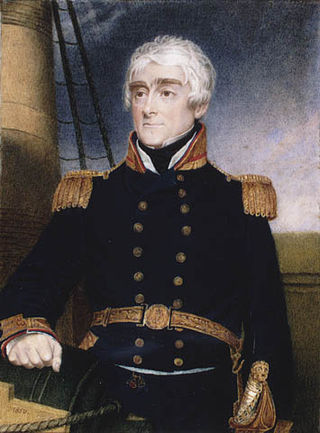Admiral Sir William Wordsworth Fisher was a Royal Navy officer who captained a battleship at the Battle of Jutland and became Commander-in-Chief of the Mediterranean Fleet. Arthur Marder wrote that he was "the outstanding admiral of the inter-war period".
Admiral of the Fleet Sir David Benjamin Bathurst, is a former Royal Navy officer. He is the only living person, apart from King Charles III, holding the rank of Admiral of the Fleet in the Royal Navy since the death of Lord Boyce. After training as a pilot and qualifying as a helicopter instructor, Bathurst commanded a Naval Air Squadron and then two frigates before achieving higher command in the navy. He served as First Sea Lord and Chief of the Naval Staff from 1993 to 1995: in that capacity he advised the British Government on the deployment of Naval Support including Sea Harriers during the Bosnian War.

Vice Admiral Sir Geoffrey Schomberg Arbuthnot, was a senior officer in the Royal Navy.

St Piran's is a prep school located on Gringer Hill in Maidenhead, Berkshire, England. The school was known as Cordwalles School until 1919 and has been co-educational since the 1990s.

Admiral of the Fleet Sir John Julian Robertson Oswald was a senior Royal Navy officer. After training as a gunnery specialist, Oswald commanded a frigate and then a destroyer before achieving higher command in the navy. He served as First Sea Lord and Chief of Naval Staff in the early 1990s. In that capacity he advised the British Government on the reduction in the size of the fleet under the Options for Change restructuring programme and on the deployment of Naval Support for the Gulf War in 1991: he also made the decision that members of the Women's Royal Naval Service should be allowed to serve in Royal Navy ships.

Air Chief Marshal Sir William Elliot, was a senior Royal Air Force commander.

Admiral Sir Percy Lockhart Harnam Noble, GBE, KCB, CVO was a Royal Navy officer who served in both World Wars.

Admiral Sir Assheton Gore Curzon-Howe was a British naval officer who served as Commander-in-Chief, Mediterranean Fleet from 1908 to 1910.

The Commander-in-Chief South Atlantic was an operational commander of the Royal Navy from 1939. The South American area was added to his responsibilities in 1960, and the post disestablished in 1967.

Major-General Alastair Andrew Bernard Reibey Bruce, is a journalist and television correspondent, and a senior British Army reservist and officer of arms in the Royal Household. He commanded the TA Media Operations Group before being appointed Governor of Edinburgh Castle in 2019.

Admiral Sir Arthur Cavenagh Leveson GCB was a senior officer in the Royal Navy. He was the Rear Admiral Commanding His Majesty's Australian Fleet from 9 January 1917 to 3 September 1918 and later Commander in Chief, China Station from 10 September 1922 to 22 April 1925.
Admiral Sir St. John Reginald Joseph Tyrwhitt, 2nd Baronet, was a senior Royal Navy officer who served as Second Sea Lord and Chief of Naval Personnel from 1959 to 1961.
Vice-Admiral Sir Arthur Allison Fitzroy Talbot KBE CB DSO & Bar DL was a Royal Navy officer who went on to be Commander-in-Chief, Plymouth.
Vice Admiral Sir Frank Forrester Rose KCB DSO was a Royal Navy officer who went on to be commander-in-chief of East Indies Station.

Admiral Sir Reginald John James George Macdonald was a Royal Navy officer who went on to be Commander-in-Chief, East Indies Station.
Admiral Sir Edward Bridges Rice, was a Royal Navy officer who went on to be Commander-in-Chief, The Nore.
Admiral Sir John Peter Lorne Reid GCB CVO was a Royal Navy officer who went on to be Controller of the Navy.
Rear Admiral John Gervaise Beresford Cooke CB DSC was a Royal Navy officer who became Naval Secretary.

Admiral of the Fleet Sir Charles Ogle, 2nd Baronet was a Royal Navy officer. As a junior officer, he saw action leading storming parties at the capture of Martinique and at the capture of Guadeloupe during the French Revolutionary Wars. He also took part in the landings in Egypt in the later stages of the French Revolutionary Wars.

Sir Michael Jeremiah Colman, 3rd Baronet was a British businessman. He served as director of Reckitt & Colman plc, the Church of England's First Church Estates Commissioner and founder of Summerdown, a commercial peppermint farm in Hampshire.











